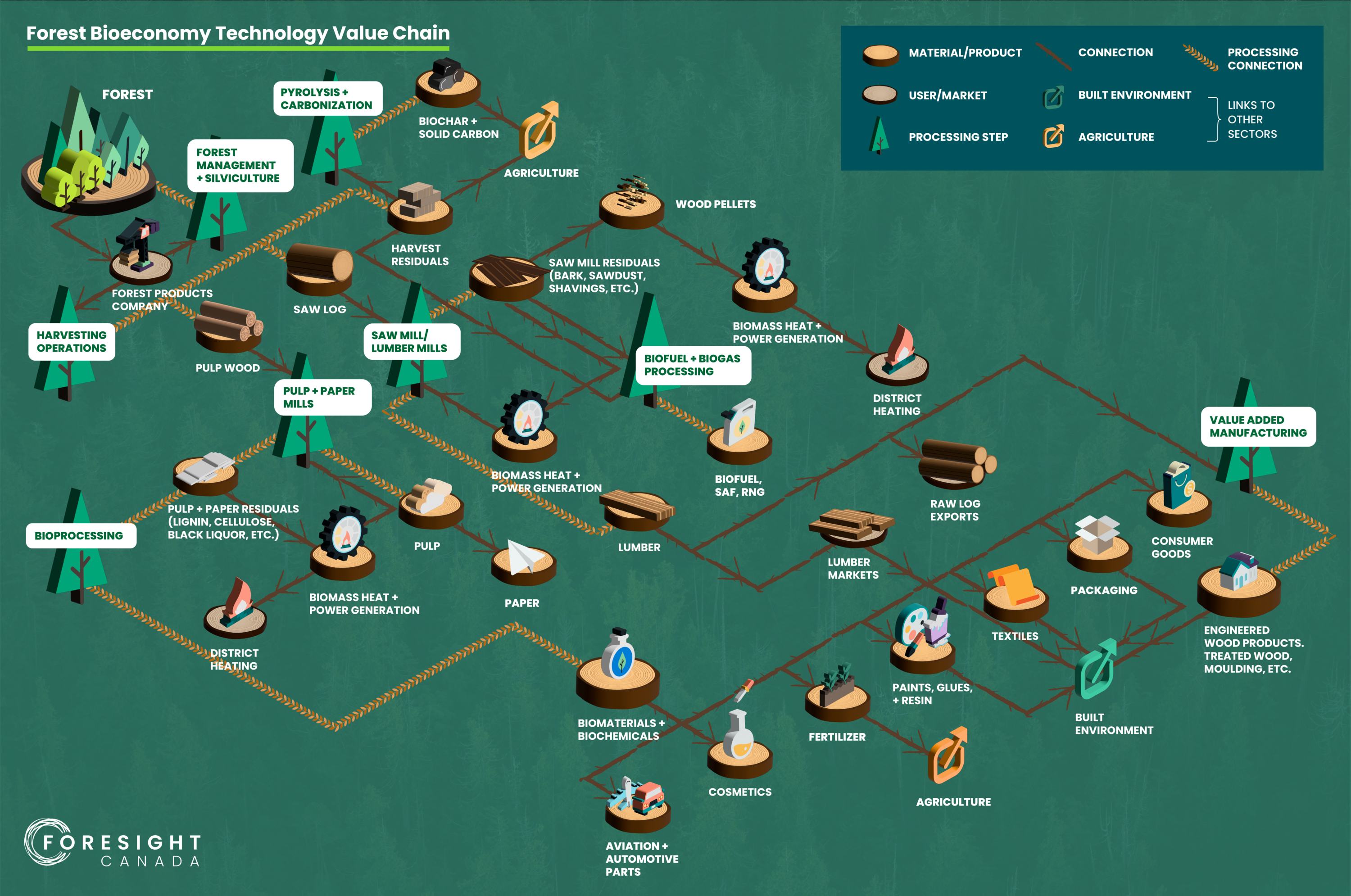Foresight’s Canada’s research team has been busy developing and launching our new Ventures to Value Chains reports where we map industries that are critical to Canada’s economy, from input to end product, illuminating the opportunities, challenges, and potential gaps along the way.
Looking for in depth ecosystem maps for some of Canada’s most critical sectors? Check out Foresight’s Ventures to Value Chains reports
Ecosystem maps can play a crucial role in helping entrepreneurs understand their company's position in a value chain by providing a comprehensive view of the business environment in which they operate. Understanding where you fit within your ecosystem is key in targeting the right customers, dealing with competition, and finding strategic partnerships that can propel you toward success.
Here's how Foresight’s Venture’s to Value Chains can help your business succeed:
Finding New Customers
The process of developing clean technologies can be very risky. Timelines for cleantech development are long, and with low rates of adoption in Canada, finding domestic customers can be tricky.
Ventures to Value Chains can help you identify potential customers. By understanding exactly where you fit on a value chain, you can gain insights into market trends, customer preferences, and emerging opportunities.
Ecosystem maps like Ventures to Value Chains outline the customer journey, illuminating the ways in which companies connect to inputs, outputs, and endpoints, while illustrating the potential touchpoints and interactions customers could have with your company.
By identifying industry pain points and areas for improvement, innovators are able to tailor their products and services to current market demands, differentiate their company from competitors, and deploy their solutions at the most impactful stages along the value chain.
Understanding Your Competition
Ecosystem maps help entrepreneurs identify and analyze key stakeholders, including customers, suppliers, partners, and competitors. Understanding the needs, behaviors, and expectations of these stakeholders is essential for developing a product or service that resonates with the target audience.
Ventures to Value Chains gives you a complete view of the competitive landscape in a given sector. By outlining which companies are already in operation and where concentrations and clusters of cleantech solutions already exist, innovators can ensure their approach highlights their company’s unique selling points and how they address gaps in the market.
Finding an audience and understanding others who are trying to target the same market share can help innovators identify potential partners or collaborators within the ecosystem, or tailor their approach to ensure they are offering a novel, unique solution. Those partners may be complementary businesses, or established members of industry and utility providers who are searching for innovative solutions for their climate challenges.
Securing Strategic Partnerships
Strategic partnerships are critical for the growth, scale, and success of cleantech ventures. The right partners can give you access to resources, key market information from an insider perspective, and access to facilities and opportunities for innovators to field test their solutions, and prove their effectiveness.
Ecosystem maps provide information on the roles and relationships of various stakeholders along their sector’s value chain. Cleantech innovators can take advantage of this knowledge to identify organizations that align with their goals and can contribute to or benefit from partnerships. Ventures to Value Chains also assesses each sector for areas of strength, and areas of opportunity—where the data and supporting research suggests that there is an opportunity to meet the growing need for climate solutions.
Ecosystem maps like Ventures to Value Chains draw a clear line from input to output, identifying those key stakeholders along the way. For innovators wondering who fits near them, these are invaluable tools that can define where their technology may have the largest impact along the chain. Knowing who the key players are is essential for targeting potential partners.
Our Ventures to Value Chains ecosystem maps give you access to the data that will allow you to form strategic, impactful partnerships with organizations who need sustainable solutions the most.
Ecosystem Maps For All
Ecosystem maps empower entrepreneurs to holistically understand their business environment, enabling them to tailor their market approach to meet the evolving needs of their target audience and stay competitive.
Foresight’s Ventures to Value Chains are not just for innovators, however.
For governments and municipalities, ecosystem maps serve as blueprints to identify areas of strength, gaps, and opportunities in the innovation landscape, pinpoint areas for targeted support and where targeted R&D and project funding will deliver the greatest return on investment for Canada’s communities and environment.
Ecosystem maps are also critical for industry partners who are looking for unique insights into the Canadian innovation landscape, and serve as a tool that will help identify innovations that will help solve their most pressing sustainability challenges.
For investors, knowing where a company fits within their ecosystem map, which companies or technologies come before or after, who the competitors are, and where clusters are forming is critical information that will inform their decision making on where to invest.
Foresight’s Ventures to Value Chains

So far, our team has produced Ventures to Value Chains ecosystem maps for four key Canadian sectors: water, carbontech, mining, and the forestry bioeconomy.
- Canada’s Mining Technology Value Chain describes key steps in the mining sector from exploration to smelting and refining and identifies key opportunities along the way.
- Canada’s Carbon Technology Value Chain illustrates the journey of carbon from emission source to capture and storage, or utilization, and its connection to users, markets, or the environment.
- Canada’s Water Technology Value Chain supports our understanding of Canada’s water tech sector in order to grow its market share and impact.
- Canada’s Forest Bioeconomy Value Chain expands our understanding of the landscape of technology innovation in Canada’s forest bioeconomy, and identifies opportunities, market trends, and key stakeholders.
Interested in learning more? Our sector-specific NEXT acceleration programs can help you understand and find your place in your venture’s value chain.



